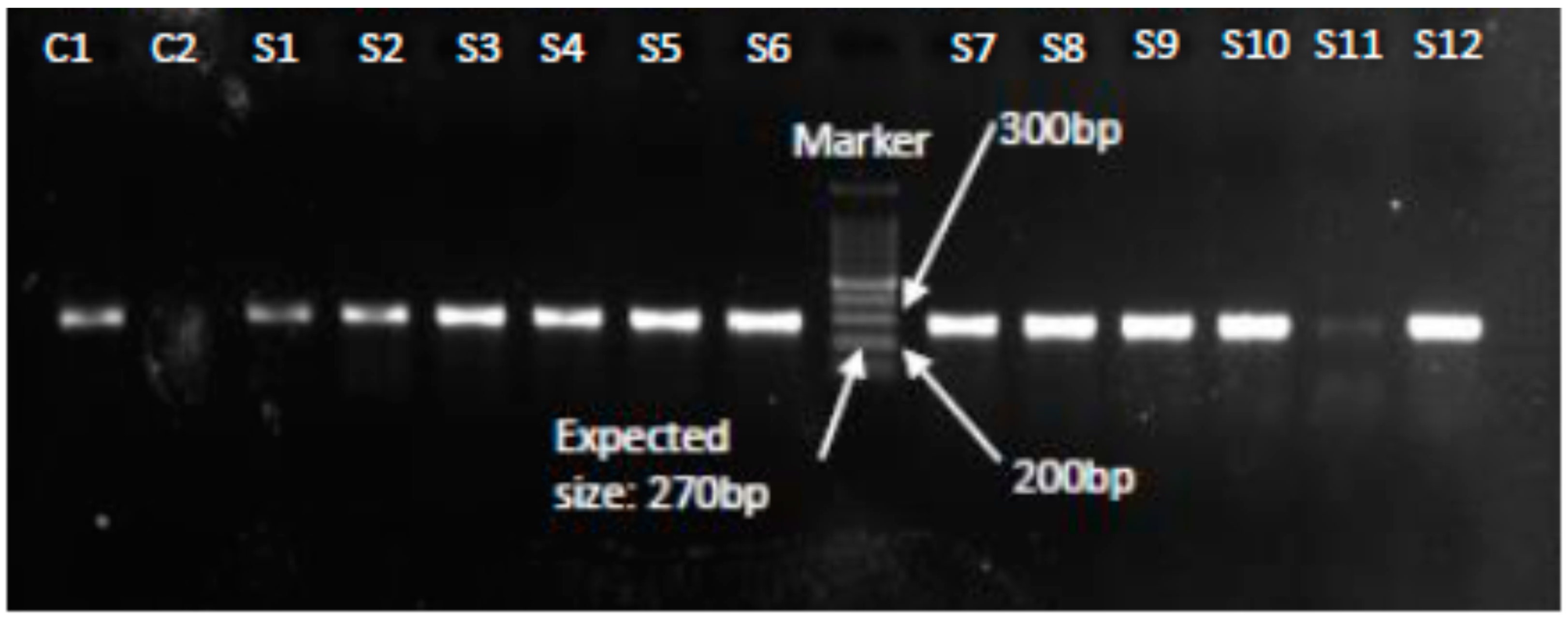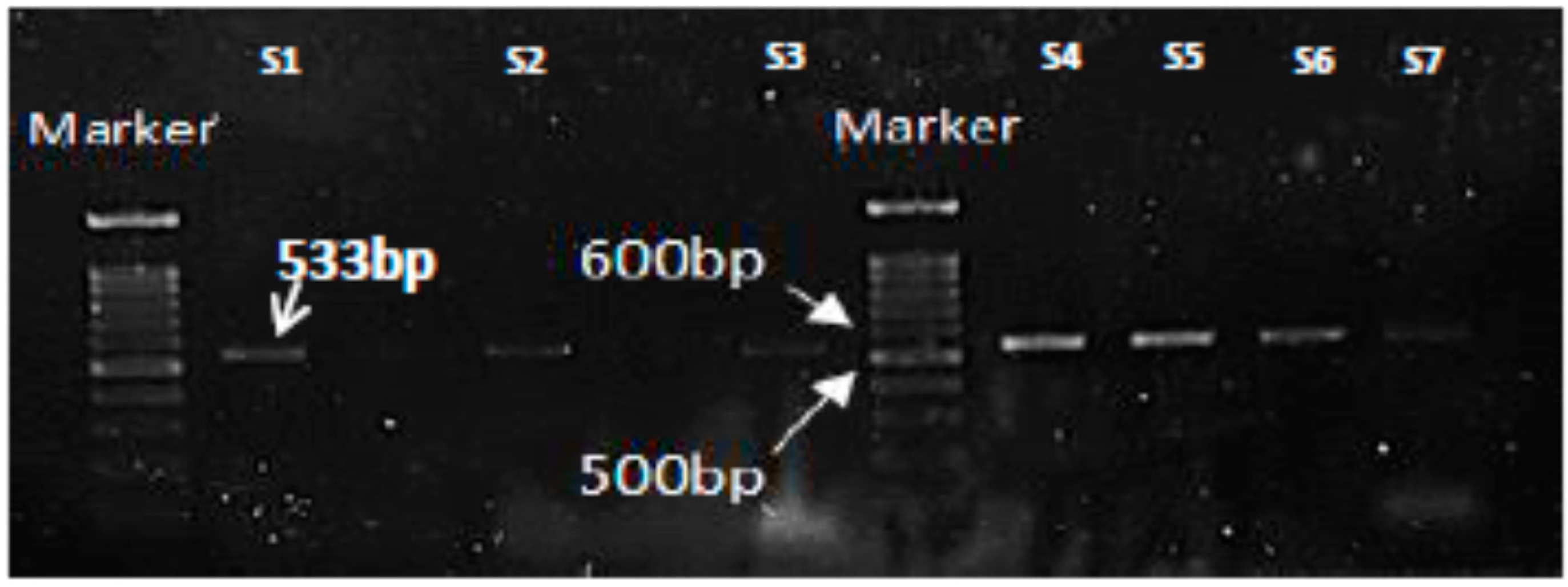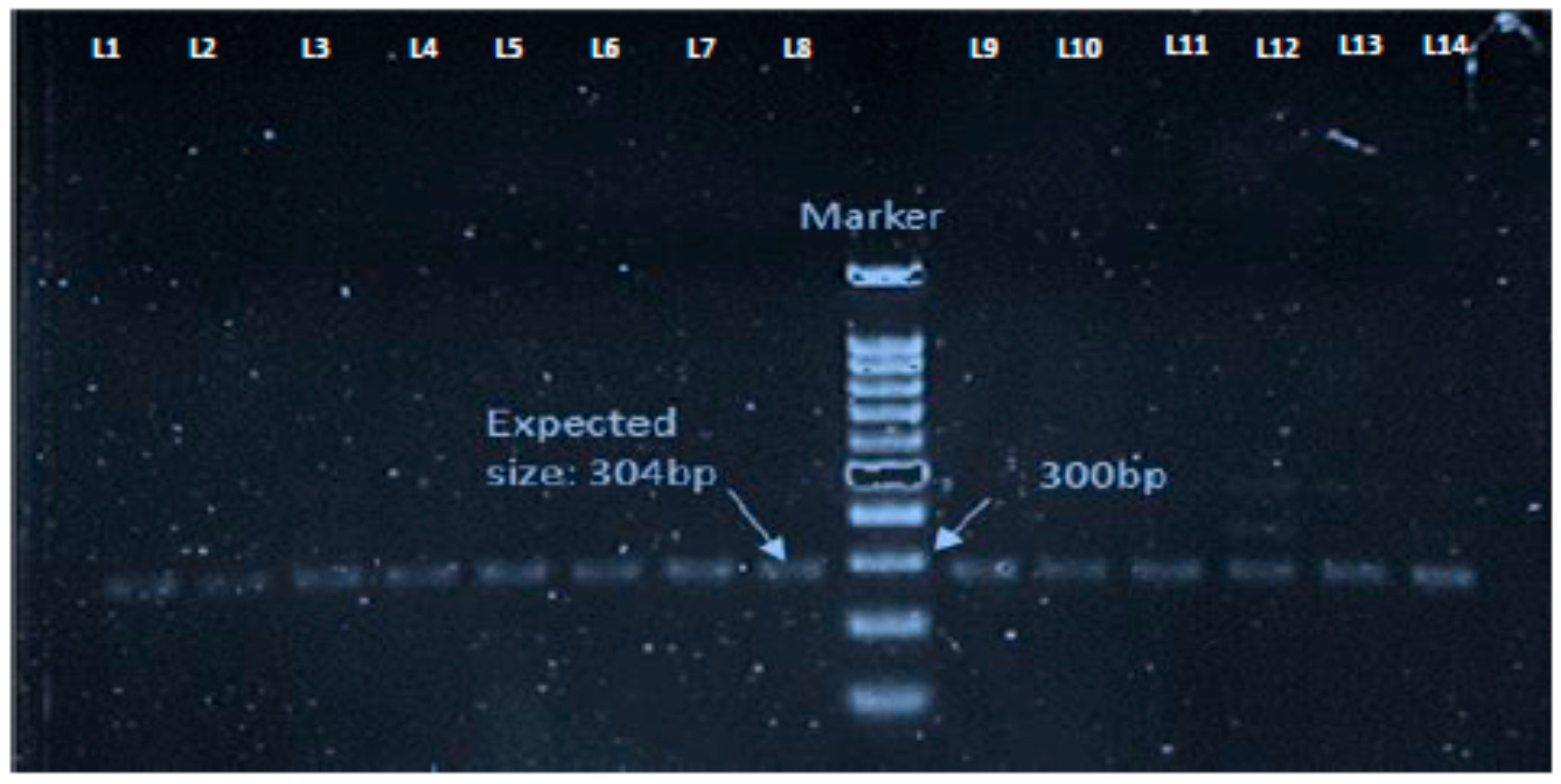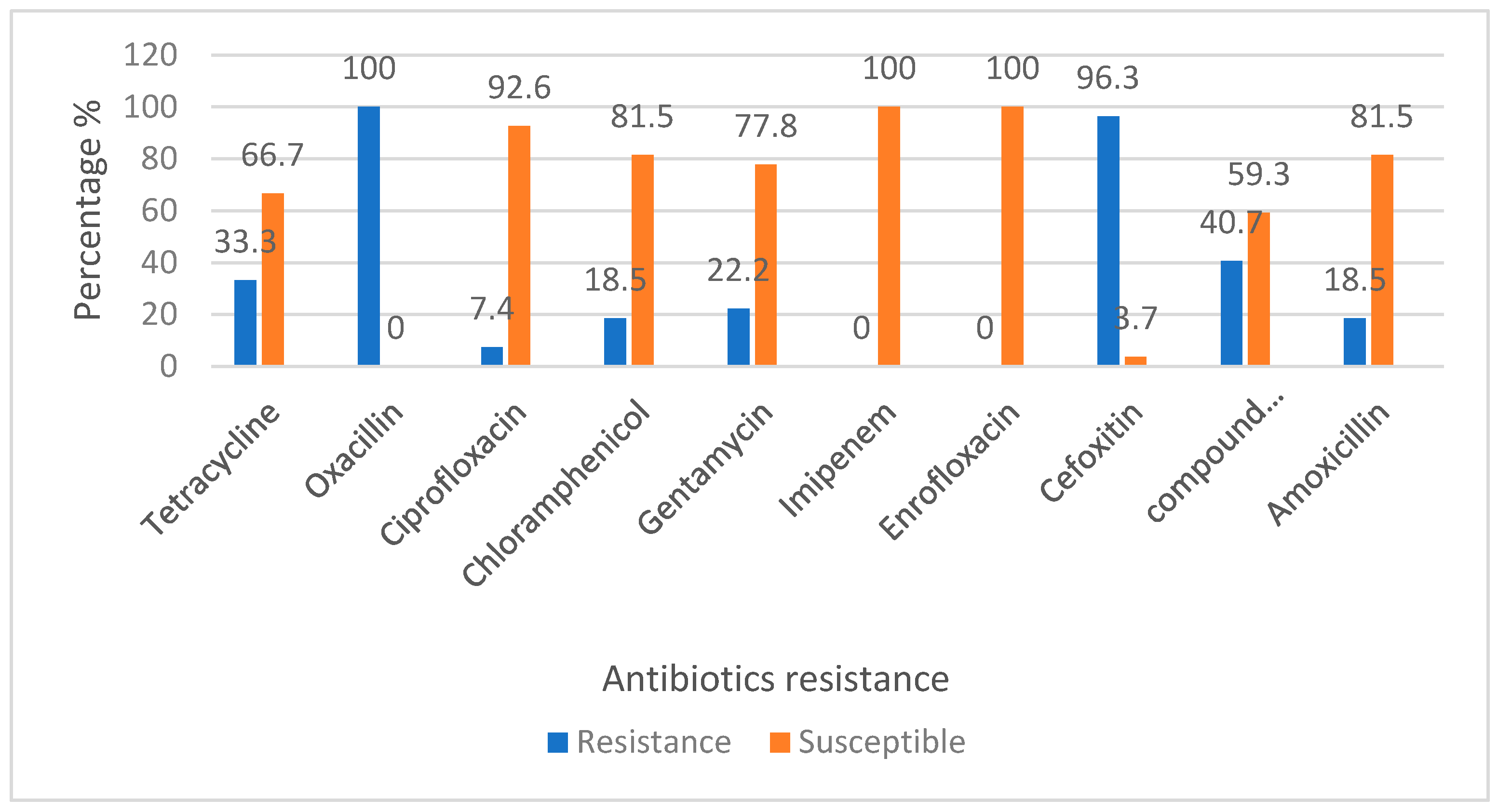First mecC and mecA Positive Livestock-Associated Methicillin Resistant Staphylococcus aureus (mecC MRSA/LA-MRSA) from Dairy Cattle in Malaysia
Abstract
1. Introduction
2. Materials and Methods
2.1. Sample Collection and Preparation
2.2. Ethics
2.3. Isolation and Identification of Staphylococcus Aureus
2.4. Antibiotic Sensitivity Test
2.5. Polymerase Chain Reaction (PCR)
2.5.1. DNA Extraction
2.5.2. S. aureus-Specific Gene Amplification
2.5.3. Amplification of Methicillin-Resistance Encoding Gene (mecA)
2.5.4. Amplification of LA-MRSA-Specific Gene (mecC)
3. Results
3.1. Isolationand Identification of S. aureus
3.2. Identification and Confirmation of MRSA
3.3. Detection of mecC Positive LA-MRSA Isolates
3.4. Antibiotic Resistance Profile of MRSA Isolates
4. Discussions
Author Contributions
Funding
Acknowledgments
Conflicts of Interest
References
- Biedenbach, D.J.; Moet, G.J.; Jones, R.N. Occurrence and antimicrobial resistance pattern comparisons among bloodstream infection isolates from the sentry antimicrobial surveillance program (1997–2002). Diagn. Microbiol. Infect. Dis. 2004, 50, 59–69. [Google Scholar] [CrossRef] [PubMed]
- Smith, T.C. Livestock-associated Staphylococcus aureus: The United States experience. PLoS Pathog. 2015, 11, e1004564. [Google Scholar] [CrossRef] [PubMed]
- Wang, W.; Lin, X.; Jiang, T.; Peng, Z.; Xu, J.; Yi, L.; Li, F.; Fanning, S.; Baloch, Z. Prevalence and characterization of Staphylococcus aureus cultured from raw milk taken from dairy cows with mastitis in Beijing, China. Front. Microbiol. 2018, 9, 1123. [Google Scholar] [CrossRef] [PubMed]
- Jayaweera, J.A.A.S.; Kumbukgolla, W.W. Antibiotic resistance patterns of methicillin-resistant Staphylococcus aureus (MRSA) isolated from livestock and associated farmers in Anuradhapura, Sri Lanka. Germs 2017, 7, 132–139. [Google Scholar] [CrossRef]
- Paterson, G.K.; Larsen, J.; Harrison, E.M.; Larsen, A.R.; Morgan, F.J.; Peacock, S.J.; Parkhill, J.; Zadoks, R.N.; Holmes, M.A. First detection of livestock-associated methicillin-resistant Staphylococcus aureus CC398 in bulk tank milk in the United Kingdom. Euro Surveill. 2012, 17, 20337. [Google Scholar]
- Aires-de-Sousa, M. Methicillin-resistant Staphylococcus aureus among animals: Current overview. Clin. Microbiol. Infect. 2017, 23, 373–380. [Google Scholar] [CrossRef]
- Bardiau, M.; Yamazaki, K.; Duprez, J.N.; Taminiau, B.; Mainil, J.G.; Ote, I. Genotypic and phenotypic characterization of methicillin- resistant Staphylococcus aureus (MRSA) isolated from milk of bovine mastitis. Lett. Appl. Microbiol. 2013, 57, 181–186. [Google Scholar] [CrossRef]
- Pu, W.; Su, Y.; Li, J.; Li, C.; Yang, Z.; Deng, H.; Ni, C. High incidence of Oxacillin-susceptible mecA-Positive Staphylococcus aureus (OS-MRSA) associated with bovine mastitis in China. PLoS ONE 2014, 9, e88134. [Google Scholar] [CrossRef]
- Kumar, R.; Yadav, B.R.; Singh, R.S. Antibiotic resistance and pathogenicity factors in Staphylococcus aureus isolated from mastitic Sahiwal cattle. J. Biosci. 2011, 36, 175–188. [Google Scholar] [CrossRef]
- van Loo, I.; Huijsdens, X.; Tiemersma, E.; de Neeling, A.; van de Sande-Bruinsma, N.; Beaujean, D.; Voss, A.; Kluytmans, J. Emergence of methicillin-resistant Staphylococcus aureus of animal origin in humans. Emerg. Infect. Dis. 2007, 13, 1834–1839. [Google Scholar] [CrossRef]
- Hanselman, B.A.; Kruth, S.A.; Rousseau, J.; Low, D.E.; Willey, B.M.; McGeer, A.; Weese, J.S. Methicillin-resistant Staphylococcus aureus colonization in veterinary personnel. Emerg. Infect. Dis. 2006, 12, 1933–1938. [Google Scholar] [CrossRef] [PubMed]
- Persoons, D.; Van Hoorebeke, S.; Hermans, K.; Butaye, P.; De Kruif, A.; Haesebrouck, F.; Dewulf, J. Methicillin-resistant Staphylococcus aureus in poultry. Emerg. Infect. Dis. 2009, 15, 452–453. [Google Scholar] [CrossRef] [PubMed]
- Lim, S.K.; Nam, H.M.; Jang, G.C.; Lee, H.S.; Jung, S.C.; Kim, T.S. Transmission and persistence of methicillin-resistant Staphylococcus aureus in milk, environment, and workers in dairy cattle farms. Foodborne Pathog. Dis. 2013, 10, 731–736. [Google Scholar] [CrossRef] [PubMed]
- Fluit, A.C. Livestock-associated Staphylococcus aureus. Clin. Microbiol. 2012, 18, 735–744. [Google Scholar] [CrossRef] [PubMed]
- Bietrix, J.; Kolenda, C.; Sapin, A.; Haenni, M.; Madec, J.Y.; Bes, M.; Dupieux, C.; Tasse, J.; Laurent, F. Persistence and diffusion of mecC-positive CC130 MRSA isolates in dairy farms in Meurthe-et-Moselle County (France). Front. Microbiol. 2019, 10, 47. [Google Scholar] [CrossRef]
- Giacinti, G.; Carfora, V.; Caprioli, A.; Sagrafoli, D.; Marri, N.; Giangolini, G.; Amoruso, R.; Iurescia, M.; Stravino, F.; Dottarelli, S.; et al. Prevalence and characterization of methicillin-resistant Staphylococcus aureus carrying mecA or mecC and methicillin-susceptible Staphylococcus aureus in dairy sheep farms in central Italy. J. Dairy Sci. 2017, 100, 7857–7863. [Google Scholar] [CrossRef]
- Aklilu, E.; Zakaria, Z.; Hassan, L.; Hui Cheng, C. Molecular relatedness of Methicillin-resistant Staphylococcus aureus isolates from staff, environment and pets at university veterinary hospital in Malaysia. PLoS ONE 2012, 7, e43329. [Google Scholar] [CrossRef]
- Clinical and Laboratory Standards Institute. Updated Standard Performance for Antimicrobial Susceptibility Testing. M100-S23 (M02-A11). Disc Diffusion Supplemental Table; Clinical and Laboratory Standards Institute: Wayne, PA, USA, 2013. [Google Scholar]
- Pinto, B.; Chenoll, E.; Aznar, R. Identification and typing of food-borne Staphylococcus aureus by PCR-based techniques. Syst. Appl. Microbiol. 2005, 28, 340–352. [Google Scholar] [CrossRef]
- Murakami, K.; Minamide, W.; Wada, K.; Nakamura, E.; Teraoka, H.; Watanabe, S. Identification of methicillin-resistant strains of staphylococci by polymerase chain reaction. J. Clin. Microbiol. 1991, 29, 2240–2244. [Google Scholar] [CrossRef]
- Monecke, S.; Gavier-Widen, D.; Mattsson, R.; Rangstrup-Christensen, L.; Lazaris, A.; Coleman, D.C.; Shore, A.C.; Ehricht, R. Detection of mecC-positive Staphylococcus aureus (CC130-MRSA-XI) in diseased European hedgehogs (Erinaceus europaeus) in Sweden. PLoS ONE 2013, 8, e66166. [Google Scholar] [CrossRef]
- Ballhausen, B.; Kriegeskorte, A.; Schleimer, N.; Peters, G.; Becker, K. The mecA homolog mecC confers resistance against beta-lactams in Staphylococcus aureus irrespective of the genetic strain background. Antimicrob. Agents Chemother. 2014, 58, 3791–3798. [Google Scholar] [CrossRef] [PubMed]
- Hoque, M.N.; Dasa, Z.C.; Rahmana, A.N.M.A.; Haiderb, M.G.; Islamc, M.A. Molecular characterization of Staphylococcus aureus strains in bovine mastitis milk in Bangladesh. Int. J. Vet. Sci. Med. 2018, 6, 53–60. [Google Scholar] [CrossRef] [PubMed]
- Wang, D.; Wang, Z.; Yan, Z.; Wub, J.; Ali, T.; Li, J.; Lv, Y.; Han, B. Bovine mastitis Staphylococcus aureus: Antibiotic susceptibility profile, resistance genes and molecular typing of methicillin-resistant and methicillin-sensitive strains in China. Infect. Genet. Evol. 2015, 31, 9–16. [Google Scholar] [CrossRef] [PubMed]
- Erskine, R.J.; Walker, R.D.; Bolin, C.A.; Bartlett, P.C.; White, D.G. Trends in antibacterial susceptibility of mastitis pathogens during a seven-year period. J. Dairy Sci. 2002, 85, 1111–1118. [Google Scholar] [CrossRef]
- Anderson, K.L.; Lyman, R.L.; Bodeis-Jones, S.M.; White, D.G. Genetic diversity and antimicrobial susceptibility profiles among mastitis-causing Staphylococcus aureus isolated from bovine milk samples. Am. J. Vet. Res. 2006, 67, 1185–1191. [Google Scholar] [CrossRef]
- Wang, X.; Li, G.; Xia, X.; Yang, B.; Xi, M.; Meng, J. Antimicrobial susceptibility and molecular typing of methicillin-resistant Staphylococcus aureus in retail foods in Shaanxi, China. Foodborne Pathog. Dis. 2014, 11, 281–286. [Google Scholar] [CrossRef]
- Basanisi, M.G.; La Bella, G.; Nobili, G.; Franconieri, I.; La Salandra, G. Genotyping of methicillin-resistant Staphylococcus aureus (MRSA) isolated from milk and dairy products in South Italy. Food Microbiol. 2017, 62, 141–146. [Google Scholar] [CrossRef]
- Magro, G.; Biffani, S.; Minozzi, G.; Ehricht, R.; Monecke, S.; Luini, M.; Piccinini, R. Virulence genes of Staphylococcus aureus from dairy cow mastitis and contagiousness risk. Toxins 2017, 9, 195. [Google Scholar] [CrossRef]
- Huber, H.; Koller, S.; Giezendanner, N.; Stephan, R.; Zweifel, C. Prevalence and characteristics of methicillin-resistant Staphylococcus aureus in humans in contact with farm animals, in livestock, and in food of animal origin, Switzerland. Euro Surveill. 2010, 15, 19542. [Google Scholar]
- Spohr, M.; Rau, J.; Friedrich, A.; Klittich, G.; Fetsch, A.; Guerra, B.; Hammerl, J.A.; Tenhagen, B.A. Methicillin-Resistant Staphylococcus aureus (MRSA) in three dairy herds in Southwest Germany. Zoonoses Public Health 2011, 58, 252–261. [Google Scholar] [CrossRef]
- Juhasz-Kaszanyitzky, E.; Janosi, S.; Somogy, P. MRSA transmission between cows and humans. Emerg. Infect. Dis. 2007, 13, 630–632. [Google Scholar] [CrossRef] [PubMed]
- Paterson, G.K.; Harrison, E.M.; Holmes, M.A. The emergence of mecC methicillin-resistant Staphylococcus aureus. Trends Microbiol. 2014, 22, 42–47. [Google Scholar] [CrossRef]
- Kreausukon, K.; Fetsch, A.; Kraushaar, B.; Alt, K.; Muller, K.; Krömker, V.; Zessin, K.H.; Käsbohrer, A.; Tenhagen, B.A. Prevalence, antimicrobial resistance, and molecular characterization of methicillin-resistant Staphylococcus aureus from bulk tank milk of dairy herds. J. Dairy Sci. 2012, 95, 4382–4388. [Google Scholar] [CrossRef]
- Hata, E.; Katsuda, K.; Kobayashi, H.; Uchida, I.; Tanaka, K.; Eguchi, M. Genetic variation among Staphylococcus aureus strains from bovine milk and their relevance to methicillin-resistant isolates from humans. J. Clin. Microbiol. 2010, 48, 2130–2139. [Google Scholar] [CrossRef] [PubMed]
- Gomes, F.; Henriques, M. Control of bovine mastitis: Old and recent therapeutic approaches. Curr. Microbiol. 2015, 72, 377–382. [Google Scholar] [CrossRef] [PubMed]
- American Veterinary Medical Association (AVMA) MRSA and Animals FAQ. Available online: https://www.avma.org/KB/Resources/Reference/Pages/Methicillin-resistant-Staphylococcus-aureus.aspx (accessed on 17 October 2019).
- Spoor, L.E.; McAdam, P.R.; Weinert, L.A.; Rambaut, A.; Hasman, H.; Aarestrup, F.M.; Kearns, A.M.; Larsen, A.R.; Skov, R.L.; Fitzgerald, J.R. Livestock origin for a human pandemic clone of community-associated methicillinresistant Staphylococcus aureus. MBio 2013, 4, e00356-13. [Google Scholar] [CrossRef]
- Wulf, M.W.; Sorum, M.; van Nes, A.; Skov, R.; Melchers, W.J. Prevalence of methicillin-resistant Staphylococcus aureus among veterinarians: An international study. Clin. Microbiol. Infect. 2008, 14, 29–34. [Google Scholar] [CrossRef]
- O’Mahony, R.; Abbott, Y.; Leonard, F.C.; Markey, B.K.; Quinn, P.J.; Pollock, P.J.; Fanning, S.; Rossney, A.S. Methicillin resistant Staphylococcus aureus(MRSA) isolated from animals and veterinary personnel in Ireland. Vet. Microbiol. 2005, 109, 285–296. [Google Scholar] [CrossRef]
- Paterson, G.K.; Larsen, A.; Robb, A.; Edwards, G.; Penycott, T.; Foster, G.; Mot, D.; Hermans, K.; Baert, K.; Peacock, S.J.; et al. The newly described mecA homologue, mecALGA251, is present in methicillin-resistant Staphylococcus aureus isolates from a diverse range of host species. J. Antimicrob. Chemother. 2012, 67, 2809–2813. [Google Scholar] [CrossRef]




| Isolate | Target Gene | Primer Sequence | Amplification Products (bp) | Reference |
|---|---|---|---|---|
| S.aueus | nucA | F 5′-GCGATTGATGGTGATACGGTT-3′ R5′-AGCCAAGCCTTGACGAACTAAAGC-3′ | 270 | [19] |
| MRSA | mecA | F 5′-CCTAGTAAAGCTCCGGAA-3′ R 5′-CTAGTC-CATTCGGTCCA-3′ | 533 | [20] |
| LA-MRSA | mecC | F 5′TGTTGTAGCAATGTTCACAC-3′ R 5′CAAGCACTTAATATCAACGC-3′ | 304 | [21] |
| Source | Samples | Positive for nucA | Percentage of S. aureus (%) |
|---|---|---|---|
| Milk | 63 | 28 | 44.4 |
| Nasal swabs | 32 | 16 | 50.0 |
| Total | 95 | 44 | 46.3 |
| Source | Samples | Positive ORSAB | Positive for mecA | Percentage of MRSA (%) |
|---|---|---|---|---|
| Milk | 63 | 22 | 13 | 20.63 |
| Nasal swabs | 32 | 4 | 4 | 12.50 |
| Total | 95 | 26 | 17 | 17.89 |
| Source | Samples | Positive ORSAB | Positive mecC Gene | Percentage LA-MRSA (%) | Positive for both mecA and mecC Genes |
|---|---|---|---|---|---|
| Milk | 63 | 22 | 11 | 17.46 | 8 |
| Nasal swabs | 32 | 4 | 4 | 12.50 | 4 |
| Total | 95 | 26 | 15 | 15.79 | 12 |
© 2020 by the authors. Licensee MDPI, Basel, Switzerland. This article is an open access article distributed under the terms and conditions of the Creative Commons Attribution (CC BY) license (http://creativecommons.org/licenses/by/4.0/).
Share and Cite
Aklilu, E.; Chia, H.Y. First mecC and mecA Positive Livestock-Associated Methicillin Resistant Staphylococcus aureus (mecC MRSA/LA-MRSA) from Dairy Cattle in Malaysia. Microorganisms 2020, 8, 147. https://doi.org/10.3390/microorganisms8020147
Aklilu E, Chia HY. First mecC and mecA Positive Livestock-Associated Methicillin Resistant Staphylococcus aureus (mecC MRSA/LA-MRSA) from Dairy Cattle in Malaysia. Microorganisms. 2020; 8(2):147. https://doi.org/10.3390/microorganisms8020147
Chicago/Turabian StyleAklilu, Erkihun, and Hui Ying Chia. 2020. "First mecC and mecA Positive Livestock-Associated Methicillin Resistant Staphylococcus aureus (mecC MRSA/LA-MRSA) from Dairy Cattle in Malaysia" Microorganisms 8, no. 2: 147. https://doi.org/10.3390/microorganisms8020147
APA StyleAklilu, E., & Chia, H. Y. (2020). First mecC and mecA Positive Livestock-Associated Methicillin Resistant Staphylococcus aureus (mecC MRSA/LA-MRSA) from Dairy Cattle in Malaysia. Microorganisms, 8(2), 147. https://doi.org/10.3390/microorganisms8020147




